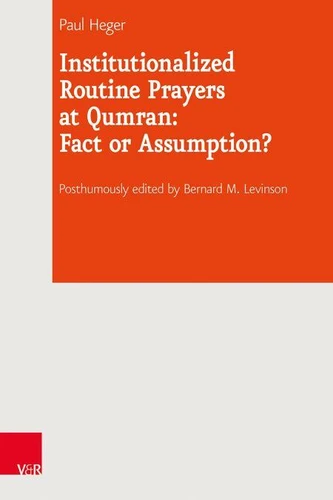Institutionalized Routine Prayers at Qumran: Fact or Assumption?
Par : , , ,Formats :
Disponible dans votre compte client Decitre ou Furet du Nord dès validation de votre commande. Le format PDF est :
- Compatible avec une lecture sur My Vivlio (smartphone, tablette, ordinateur)
- Compatible avec une lecture sur liseuses Vivlio
- Pour les liseuses autres que Vivlio, vous devez utiliser le logiciel Adobe Digital Edition. Non compatible avec la lecture sur les liseuses Kindle, Remarkable et Sony
 , qui est-ce ?
, qui est-ce ?Notre partenaire de plateforme de lecture numérique où vous retrouverez l'ensemble de vos ebooks gratuitement
Pour en savoir plus sur nos ebooks, consultez notre aide en ligne ici
- Nombre de pages317
- FormatPDF
- ISBN978-3-647-57131-7
- EAN9783647571317
- Date de parution16/09/2019
- Protection num.pas de protection
- Taille7 Mo
- Infos supplémentairespdf
- ÉditeurVandenhoeck & Ruprecht
Résumé
This book examines the development of institutionalized prayer in ancient Israel at a crucial time in the history of Western civilization: from the period of the Qumran writings, in the last three centuries BCE, through to the rabbinic period, after 70 CE. It explores the shift from sacrificial worship by priests to abstract, unmediated, direct approaches to the deity by laypeople. It demonstrates the transition from voluntary, freely composed prayers to obligatory prayers with fixed texts.
The study shows how Qumran and Samaritan prayer contrast with rabbinic prayer, shedding light on Jewish customs before the rabbinic reform. Posthumously edited by Bernard M. Levinson.
The study shows how Qumran and Samaritan prayer contrast with rabbinic prayer, shedding light on Jewish customs before the rabbinic reform. Posthumously edited by Bernard M. Levinson.
This book examines the development of institutionalized prayer in ancient Israel at a crucial time in the history of Western civilization: from the period of the Qumran writings, in the last three centuries BCE, through to the rabbinic period, after 70 CE. It explores the shift from sacrificial worship by priests to abstract, unmediated, direct approaches to the deity by laypeople. It demonstrates the transition from voluntary, freely composed prayers to obligatory prayers with fixed texts.
The study shows how Qumran and Samaritan prayer contrast with rabbinic prayer, shedding light on Jewish customs before the rabbinic reform. Posthumously edited by Bernard M. Levinson.
The study shows how Qumran and Samaritan prayer contrast with rabbinic prayer, shedding light on Jewish customs before the rabbinic reform. Posthumously edited by Bernard M. Levinson.



